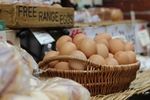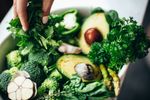Browsing the grocery store aisles trying to decipher what really is healthy and what isn’t can make your head spin. With a range of claims slapped on food products, including “all-natural,” “sugar-free” or "low-fat," it can be difficult to know what to trust — and what's potentially misleading.
First things first: Keeping it simple is key, says health coach Raj Barker. Ideally, aim to fill your cart mostly with foods that don't have any label at all — meaning they’re as close as possible to their natural state. (Think: apples, avocados, nuts and seeds.)
But we know that’s not going to check off all your grocery needs. Below, the experts share advice to help you navigate the confusing labels, terms and seals in the grocery store with ease.
Fruits and Veggies: Go Organic (When Possible)
When shopping for fruits and vegetables, buying organic certifies that what you’re ingesting has a low exposure to pesticides. Why is this a good thing? Pesticides can affect our health in a number of detrimental ways, Barker notes. For women, it can impact the thyroid and hormones, but pesticides can affect gut health and brain health for everyone.
Going to your local farmers market is a great way to shop local, organic fruits and veggies, plus it opens up the opportunity to have conversations with individual farmers about their produce and practices. Bonus: The produce is often less expensive than what you’ll find at the supermarket.
RELATED: Shop The Summer Farmers Market Like A Chef
If organic isn't always a possibility, that's okay. Barker recommends just trying to prioritize going organic for the Dirty Dozen, which ranks the fruits and veggies with the highest levels of pesticides. It includes kale, nectarines, grapes and other fruits and veggies with soft or more porous skins. “Typically produce with a thicker skin (such as bananas, avocados or oranges) won’t be sprayed with as much pesticides because it’s harder for bugs to eat through the outer layer,” explains Barker.
Helpful hint: A fast way to figure out if a fresh fruit or veggie is organic: look for a sticker that has a series of numbers starting with the number nine.
Meat, Dairy and Eggs: Prioritize Pasture-Raised and Grass-Fed
“The best label to look for when shopping for animal products is pasture-raised,” explains health coach Katrine van Wyk. This means the animal was outside with freedom and space to roam, soaking up sun and eating their natural diet of grasses.
“Sunlight converts to vitamin D in the body, which is a really important distinction between animals that have been kept indoors versus outside,” says van Wyk, adding that pasture-raised animals have higher levels of omega 3 fatty acid, vitamin A and fewer pro-inflammatory fats.
When buying eggs, "cage-free" and "free-range" are two common (FDA-regulated) labels you'll see, but they don't actually mean much. All they signify, respectively, is that the hens aren't kept in cages — they can access the outdoors, but that could be a screened-in porch.
"The best label to look for when shopping for animal products is pasture-raised."
The next best option: Go for grass-fed meats and animal products, Barker suggests. “Rather than being fed a grain-based diet, which can often be genetically modified, animals that consumed predominantly grass are higher in omega 3 fatty acids as well as CLA (conjugated linoleic acid),” she explains. (CLA is a beneficial nutrient that has been shown to have potential fat-burning and weight-loss benefits). The same goes for dairy — CLA will be more predominant in a grass-fed animal’s milk than it will be in something that is grain-fed. "It's also better to buy grass-fed milk over organic milk because organic is almost always processed at very high temperatures to extend shelf life, but the process kills many of milk’s natural nutrients," explains Laura Allen, Director of Food and Beverage at THE WELL.
Even though red meat often gets a bad rap, van Wyk says, a lot of the studies that we hear about red meat being inflammatory are done on factory-farmed, corn-fed, industrialized meat, which will be more inflammatory. However, a piece of pasture-raised or grass-fed meat may not have the same effect on the body.
A farmers market is a great place to buy meat, says Allen: “Most farmers markets vet their fish and meat vendors, so the research has already been done. You can buy anything there knowing that it has been grown with sustainable practices."
Lastly: Ever wondered what "organic" meat really means? "When it comes to animal products, ‘organic’ often refers to the feed that the animal was given," van Wyk says. So an organic chicken could have been fed organic corn and grains — and wasn't necessarily grass-fed. The good news is that their diet was free from pesticides — making organic meat another good option.

Seafood: Choose Wild-Caught
Seafood is a nutrient-dense addition to anyone’s diet; however, it can be difficult to navigate as knowledge of polluted oceans and increased farming cloud buying options. Barker and van Wyk both agree: When shopping for seafood, prioritize wild-caught fish over farmed.
“Wild-caught means the fishing is done in the fish’s natural habitat. The fish is eating foods it’s meant to be eating (like algaes) which provide a lot of the good fats as opposed to having been farmed where it’s in confines and fed a man-made diet (typically grains),” says Barker. Trouble finding wild caught salmon in the fresh or frozen section? Van Wyk suggests buying smoked or canned wild caught salmon to deliver the nutrition from the fish in a more readily available way.
However, “some wild fish farming practices are not sustainable. Dredging and trawling are two widespread practices that pick up everything in a boat's path, instead of isolating for a desirable species. Look for line caught or pole caught which doesn't produce as much by-catch," says Allen, adding: “Shellfish get their nutrients from water and not from feed, so farmed shellfish — which takes place in the ocean — actually help filter their habitat instead of polluting their surroundings.”
For questions about sustainable seafood options near you, van Wyk also recommends downloading the Seafood Watch app from the Monterey Bay Aquarium. “The seafood shopping experience can change depending on where you live, what region you’re in, what season, so it’s definitely helpful to have something like this to help navigate,” she explains.
Grains: Go Organic to Avoid GMOs and Pesticides
As wheat, corn and soy are becoming increasingly genetically modified and the use of industrialized farming (which means higher pesticide use) escalates, van Wyk highly recommends choosing organic when having wheat.
Glyphosate, the leading ingredient in the poison Roundup, is used on crops like wheat and corn and is toxic to humans — linked to cancer, hormone disruption and damaged gut microbiomes. In this study, researchers report that glyphosate’s negative impact on the body is insidious and manifests slowly over time as inflammation damages cellular systems throughout the body.
Your Guide to Decoding Food Labels
Although some label claims are regulated by the USDA (like non-GMO and organic), many are not and can be misleading.
Below, Barker and van Wyk break down common claims:
- Natural: This marketing buzzword more or less means nothing. If you see an item claiming to be “natural,” read the ingredients to see if they back up the claim.
- Non-GMO: This means it is made with ingredients that have not been genetically modified. This label is especially used on products that contain corn or soybean (most common GMO foods in America).
- Sugar-Free: This term is especially devious and can be very misleading. Often if products claim to be sugar-free, there are added artificial or alternative sweeteners (like aspartame, saccharine or sucralose that are worse for you than sugar!) to keep the product sweet. If you see "sugar-free" on a label, check to see what other sweeteners they’ve added instead. Some other sugar alternatives — like xylitol or sorbitol — can cause digestive distress. Best to stear clear!
- No Added Hormones: Federal regulations don’t allow for added hormones in poultry or pork, so this is, once again, more of a marketing term that reiterates the minimum standards set by the USDA. This statement can be misleading if the consumer thinks they’re buying a superior product, when in actuality the product is meeting the base level regulations.
- Hormone-Free: Similar to “no added hormones,” it can reiterate the minimum standard. But the exception is for red meat: When purchasing beef, make sure that it does state “hormone-free” or “no added hormones” to verify that the animal was raised without the use of hormones or antibiotics.
- Low-Fat/Fat-Free: Especially used for dairy products, this means the product has been processed additionally to remove the naturally occurring fats (a.k.a good fats) in the food. Dairy contains good fat soluble vitamins, so if you remove the fat from that food, then you won't get the beneficial vitamins either.
- Homogenized Milk: Homogenization is a process that disperses the fat (cream) throughout the dairy and helps milk last longer in the fridge. Unfortunately, it’s another step of processing that takes away good enzymes and nutrients. If possible, buy organic pasteurized dairy instead of homogenized — you may have to read the label to decipher if the milk has been homogenized or not.
- Multi-Grain: This term signifies that there is more than one grain present in a bread product. It could just contain two grains, with no indication of whether those grains are genetically modified or information regarding the quality of that grain — so it doesn't mean all that much.
- Whole Grain: When buying bread, you want to opt for whole grain over multi-grain. It means the grain used is in its most whole form without having been processed.
- Fair Trade: This means the company creates a more equitable trade relationship by favoring the rights of the workers, their conditions, rights and pay.
- Free Trade: This term focuses more on the economic growth of the participating nations and industries within the international trading system and is influenced by their individual government policies.
- Ethically Sourced: This is an unregulated term, with a meaning that can vary from brand to brand. Ideally it means care and attention went into producing and obtaining the ingredients, but a lot of times the process a brand uses isn’t put on a label. If you want to know more, dig a little deeper — if a brand really is transparent, their website will usually showcase that.
Finally, you’ll also want to check the ingredients list, keeping in mind that they appear in order of predominance with the greatest ingredient listed first. “That means if sugar is the first ingredient, it’s predominantly made up of sugar,” Barker says. Also, if water is the first, second or third ingredient listed, any health benefits might be, well, washed out.




